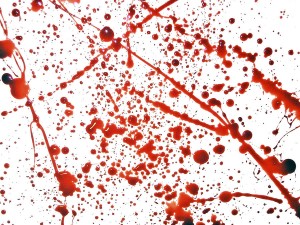 Because blood behaves according to certain scientific principles, trained bloodstain pattern analysts can examine the blood evidence left behind and draw conclusions as to how the blood may have been shed. From what may appear to be a random distribution of bloodstains at a crime scene, analysts can categorize the stains by gathering information from spatter patterns, transfers, voids and other marks that assist investigators in recreating the sequence of events that occurred after bloodshed. This form of physical evidence requires the analyst to recognize and interpret patterns to determine how those patterns were created.
Because blood behaves according to certain scientific principles, trained bloodstain pattern analysts can examine the blood evidence left behind and draw conclusions as to how the blood may have been shed. From what may appear to be a random distribution of bloodstains at a crime scene, analysts can categorize the stains by gathering information from spatter patterns, transfers, voids and other marks that assist investigators in recreating the sequence of events that occurred after bloodshed. This form of physical evidence requires the analyst to recognize and interpret patterns to determine how those patterns were created.
Bloodstain pattern analysis (BPA) is the interpretation of bloodstains at a crime scene in order to recreate the actions that caused the bloodshed. Analysts examine the size, shape, distribution and location of the bloodstains to form opinions about what did or did not happen.
BPA uses principles of biology (behavior of blood), physics (cohesion, capillary action and velocity) and mathematics (geometry, distance, and angle) to assist investigators in answering questions such as:
- Where did the blood come from?
- What caused the wounds?
- From what direction was the victim wounded?
- How were the victim(s) and perpetrator(s) positioned?
- What movements were made after the bloodshed?
- How many potential perpetrators were present?
- Does the bloodstain evidence support or refute witness statements?
Why and when is bloodstain pattern analysis used?
Bloodstain evidence is most often associated with violent acts such as assault, homicide, abduction, suicide or even vehicular accidents. Analyzing the size, shape, distribution, overall appearance and location of bloodstains at a crime scene helps investigators by answering basic questions including:
- What occurred?
- Where did the events occur?
- Approximately when and in what sequence?
- Who was there? Where were they in relation to each other?
- What did not occur?
One of the most important functions of bloodstain pattern analysis is to support or corroborate witness statements and laboratory and post-mortem findings. For example, if the medical examiner determines the cause of death is blunt force trauma to the victim’s head, the pattern and volume of blood spatter should be consistent with a blunt instrument striking the victim one or more times on the head. Conversely, if the spatter resembles that seen in expirated blood spray, the analyst will check the medical examiner or pathologist reports for injuries that can cause the presence of blood in the nose, throat or respiratory system of the victim. If blood is not reported in these locations, the analyst may be able to exclude expiration as the possible cause of that spatter pattern..
READ MORE AND GET YOU FREE EBOOK DOWNLOAD
Free eBook – Download here:
